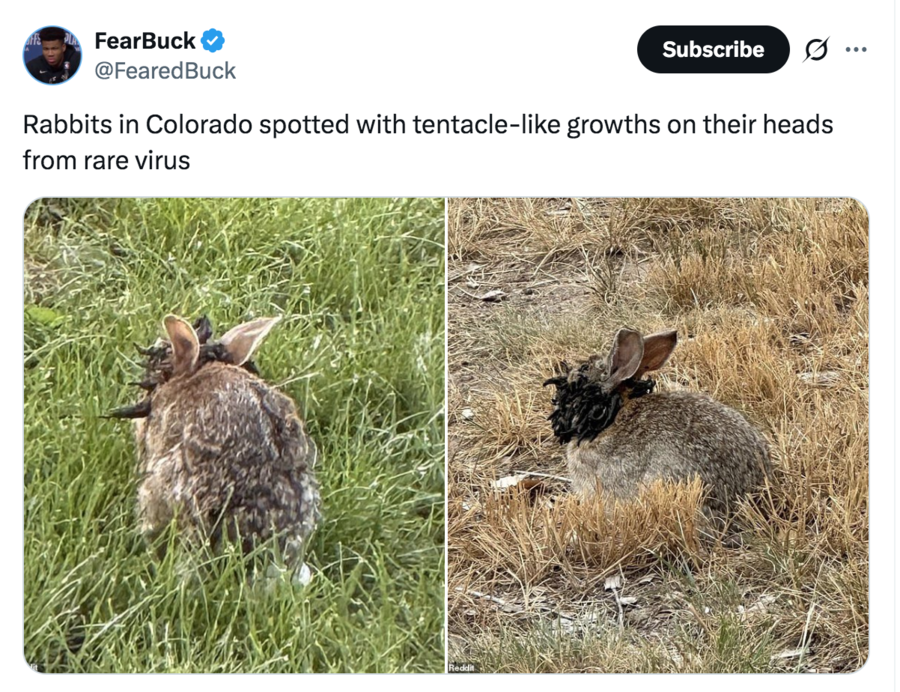
Are rabbits spotted in the wild with "weird tentacles" or "horns" infected with a rare virus, as claimed by social media users? No, this is misleading: The rabbits have a common viral infection, papillomavirus, that causes extensive skin growth that looks like horns or tentacles. A spokesperson for the Colorado Parks & Wildlife Department told Lead Stories the "wart-like growths" on the rabbits are "not uncommon." The infection has long been known to hunters and affects wild cottontail rabbits in the Midwest and on the East Coast, according to a published scientific article.
The claim appeared in a post (archived here) where it was published on X.com on August 12, 2025 It opened:
Rabbits in Colorado spotted with tentacle-like growths on their heads from rare virus
This is what the post looked like on X at the time of writing:
(X screenshot taken by Lead Stories)
The Colorado Parks & Wildlife Department explains the infection on their website (archived here):
Rabbit Papillomas
Rabbit papillomas are growths on the skin caused by the cottontail rabbit papillomavirus. The growths have no significant effects on wild rabbits unless they interfere with eating/drinking. Most infected cottontails can survive the viral infection, after which the growths will go away. For this reason, CPW does not recommend euthanizing rabbits with papillomas unless they are interfering with the rabbit's ability to eat and drink.
Kara Van Hoose, a public information officer (archived here) with the Colorado Parks & Wildlife Department, told Lead Stories via email on August 13, 2025, that they have received about a dozen reports of rabbits in the northern Colorado area with "wart-like growths" on their face but they believe it is most likely people reporting the same rabbits and not a dozen rabbits infected. She explained that the virus is not rare:
It's most likely the rabbit (or shope) papilloma virus which is not uncommon in Colorado. The virus is spread through biting insects like fleas or ticks.
She said the virus cannot spread to humans or pets and warned, "As with any wildlife, pets should not interact or come in contact with the rabbits."
An article published in 2024 on the National Library of Medicine website (archived here) titled, "A Century of Shope Papillomavirus in Museum Rabbit Specimens," explains the virus:
Rabbit papillomatosis is a viral infection caused by Sylvilagus floridanus papillomavirus (SfPV; family Papillomaviridae). It can cause extensive skin growths in cottontail rabbits, especially around the head. Although long known to hunters, the disease was first reported in 1931
SfPV growths frequently occur on the face, head, neck, and back of Sylvilagus rabbits, but may appear anywhere (on the affected animal) and can be quite cryptic when small. Growths can be several centimeters in length.
Social media posts claimed the rabbits with the virus were "invading parts of the US" without noting that the virus is common and known in the areas, like this one posted on X:
🔥🚨BREAKING: Colorado officials just sent a warning of: "DO NOT TOUCH" to their residents after rabbits were spotted invading parts of the US with weird tentacles sprouting from their heads due to virus. pic.twitter.com/f1LpxmA6Di
-- ⁿᵉʷˢ Barron Trump 🇺🇸 (@BarronTNews_) August 13, 2025
And this one also posted on X:
🚨Just in: Officials in Colorado have now warned citizens "Do Not Touch" rabbits with the black, tentacle-like protrusions or horns on their heads which spotted across Fort Collins, Colorado pic.twitter.com/X6RPWemHHp
-- The Calvin Coolidge Project (@TheCalvinCooli1) August 13, 2025
While some are calling the rabbits with the horns jackalopes, that is also not true, as jackalopes are not real. In the early 1900s two brothers were hunting Jack rabbits in Wyoming when they found one of their dead rabbits next to a pair of antlers. They taxidermied the rabbit with the antlers and the legend began, according to Live Wyld magazine (archived here).


















